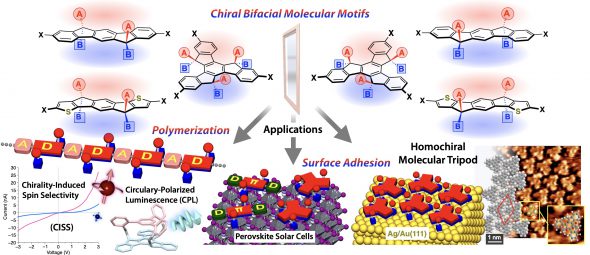-
About
- Kyoto Prize
-
Research Grants
-
Social Contributions
- Events
- News
This website uses cookies to improve the user experience. If you continue on this website, you will provide your consent to our use of cookies.
About
Research Grants
Social Contributions

Associate Professor, Graduate School of Engineering, Osaka University *Profile is at the time of the award.
2023Inamori Research GrantsScience & Engineering
My dream is to create structurally interesting functional molecules! I will do my best!
Polycyclic aromatic hydrocarbons and ladder polymers possess a unique structural feature: a “plane” within their molecular architecture. These molecules typically exhibit structural symmetry with respect to this plane. By controlling the out-of-plane symmetry of such ladder-type molecules and intentionally introducing asymmetry, it becomes possible to develop bifacial molecules—a new class of molecular systems with asymmetric properties. Such bifaciality can lead to emergent physical properties and functionalities derived from the induced asymmetry. For example, bifacial molecules can potentially align directionally when adsorbed onto solid surfaces, enabling precise control of surface and interfacial properties.
Moreover, depending on the structural symmetry of the ladder-type backbone, the out-of-plane anisotropy introduced by bifacial design can give rise to chiral physical properties. These include phenomena of growing interest such as circularly polarized luminescence (CPL) and chirality-induced spin selectivity (CISS). Motivated by this concept, we have recently developed a variety of chiral bifacial molecular motifs based on sp³-carbon-bridged ladder-type cores, including indenofluorene, indacenodithiophene, and truxene derivatives. These efforts aim at both exploring new functionalities and enabling practical applications.
To date, this research has led to several outcomes: the development of bifacial hole-transport materials; passivation of perovskite surfaces using bifacial tripod-type molecules; and investigations into CPL properties of bifacial truxene derivatives, where highly asymmetric g-factors and their mechanistic origins have been elucidated, along with demonstrations of potential device applications. In pursuit of conductive and chiral bifacial materials, a chiral donor–acceptor π-conjugated polymer was synthesized based on a bifacial indacenodithiophene (IDT) motif and benzothiadiazole. Spin-coated films of this polymer exhibited excellent CISS performance, showing a spin polarization rate of approximately 70%, as evaluated by spin-polarized conductive atomic force microscopy. More recently, we found that truxene derivatives bearing three carboxymethyl substituents function as homochiral molecular tripods, capable of highly ordered adsorption onto Ag and Au(111) surfaces.

N. Minoi, *F. Ishiwari et al. (2024) Evolving bifacial molecule strategy for surface passivation of lead halide perovskite solar cells Sustainable Energy Fuels 8, 4453–4460 DOI:10.1039/D4SE01096E
S. Li, *F. Ishiwari et al. (2024) Chiral bifacial indacenodithiophene-based π-conjugated polymers with chirality-induced spin selectivity Chem. Commun. 60, 10870–10873 DOI: 10.1039/D4CC03292F
*F. Ishiwari, T. Omine et al. (2025) Homochiral Carboxylate-Anchored Truxene Tripods: Design, Synthesis, and Monolayer Formation on Ag(111) Chem. Eur. J. 31 DOI:10.1002/chem.202404750
Science & Engineering

